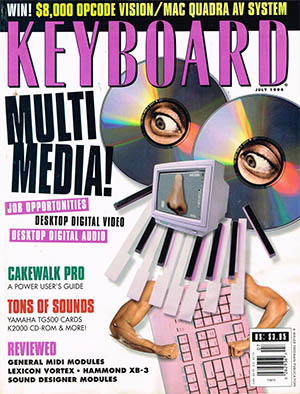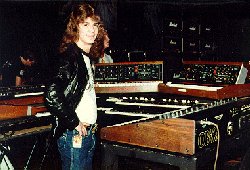|
DAVID ROSENTHAL Interview Keyboard Magazine USA NOW THE TRUTH CAN BE TOLD: David Rosenthal, your choice for Best Hired Gun in the most recent Keyboard Readers Poll, nimble-fingered synthmeister on Billy Joel's apparently endless world tour, unobtrusive colorist behind Cyndi Lauper on her True Colors dates, inexhaustible sidekick on Robert Palmer's backbreaking 1988 concert trek, master of snarling textures and scary solos with Whitesnake and Rainbow, nearly chucked it all years ago to become a guitar player!  His plea? Guilty, with an explanation. I was 12 or 13 when I started playing in cover bands," he admits. "I'd been taking piano lessons since I was seven. I had gotten my first organ, a Lowrey, and then I got a Farfisa. The only problem was that some of the popular songs on the radio didn't have keyboard. Rather than put keyboards in them, which didn't sound right, I figured I'd learn how to play guitar."
His plea? Guilty, with an explanation. I was 12 or 13 when I started playing in cover bands," he admits. "I'd been taking piano lessons since I was seven. I had gotten my first organ, a Lowrey, and then I got a Farfisa. The only problem was that some of the popular songs on the radio didn't have keyboard. Rather than put keyboards in them, which didn't sound right, I figured I'd learn how to play guitar." Fortunately, Rosenthal saw the light at the Berklee School of Music, where the picker glut brought him to his senses and steered him to a triple major in piano performance, electronic music, and audio recording. By the time he earned his degree in 1981, he was an all-stops-out, no-apology keyboard rocker with enough talent and attitude to land a gig with Rainbow. Thus began a long apprenticeship, during which Rosenthal figured out how to survive in a style defined and dominated by the guitar. His flirtation with the instrument in high school proved an invaluable lesson as he adjusted to life in the shadow of Rainbow's notoriously difficult guitarist and leader, Ritchie Blackmore. "I've worked with a lot of great guitar players, from Ritchie to Steve Vai, and in that kind of situation my role is supportive. I'm called on to make the guitar sound bigger while not drawing too much attention to myself. A lot of times you won't even hear me in the mix, but if you mute what I do, the guitars would suddenly sound smaller. That comes from being a guitar player too: I know how to make my voicings intertwine with what the guitar player does. I can watch their fingers and know exactly what they're doing." An additional asset - perfect pitch - gives Rosenthal an edge in the art of playing behind speed demon soloists. "It helps me follow exactly what they're doing," he says. "I've known I had perfect pitch since I was nine years old, when this guy who was tuning the piano in our house said to me, 'Hey, just for a joke, turn your back to the piano.' So I turned around, and he played a C and said, 'What note is this?' I said, 'it's C.' Then he said, 'What note is this?' He played an A, and I said, 'That's A.' He said, 'I can't believe it!' But I was like, 'What's the problem? You asked me what note it was and I told you.' Even now, I can't imagine not knowing what note something is when I hear it." Rosenthal has moved far beyond pitch tricks with piano techs. In fact, he's moved beyond the "hired gun" role to start his own band, Red Dawn, a stadium-rattling quintet in which the synths, for once, take a back seat to nobody. Never Say Surrender, their debut CD, is already out in Japan and the U.K., with a French release planned for June. Much of the contract haggling is done by Rosenthal between dates with Joel on the road; whatever hotel they're in is his office. As if that's not enough, he has written for music magazines in the U.S., Japan, Germany, and Australia, completed a video titled Macintosh, MIDI, & Music: The Open Door for Apple, and lectured at several colleges and industry seminars. Every now and then, we hear, he eats and sleeps. We caught up with Rosenthal the day after a Billy Joel show in San Francisco. Though he keeps a pretty low profile with Joel's band, he's not one to pull punches in conversation. At age 32, he's seasoned enough to know his business, but not too jaded to rock like a true believer. How did you learn what you needed to know about the business side of music?  Mainly by doing. I was very lucky to get into Rainbow when I was real young; I had just gotten out of Berklee when I heard that Ritchie Blackmore was looking for a new keyboard player, so I went down, auditioned cold against 50 other players, and got the gig. Once I was in I had the opportunity to observe Ritchie, learn and listen. I thought that lots of things he was doing were really cool, and a lot of other things could be done better.
Mainly by doing. I was very lucky to get into Rainbow when I was real young; I had just gotten out of Berklee when I heard that Ritchie Blackmore was looking for a new keyboard player, so I went down, auditioned cold against 50 other players, and got the gig. Once I was in I had the opportunity to observe Ritchie, learn and listen. I thought that lots of things he was doing were really cool, and a lot of other things could be done better.I kept doing the same thing on everything I did after that. It kept adding up; every step of the way, I learned more and more. I also read a lot of books on the music business. They helped with nuts-and-bolts knowledge, but there's no substitute for street knowledge. What do you learn on the street that you can't get from those books? People chops. Business is people. It doesn't matter what business you're in; it's always about how you interact with people. Everybody has their own goals. If you understand what everybody else's goals are, you can further you own. And it snowballs. The more people you meet, the bigger your network is. You meet one guy over here, and a couple of years later he turns up as president of this company over there. In your earliest days in the business, were you already making moves with the intention of getting your own act together someday? Well, I was so young at the time. I knew that being in Rainbow was good for my career, and I was having a great time. But I never really had time after school to sit and think about what I wanted to do; I just started doing it, so a lot of it wasn't that premeditated. That's actually one reason why things have gone well for me. It's important to have a plan, but you can't have an inflexible play. You keep revising it as you go. How does your approach to the keyboard sound differ between working with your own material in Red Dawn and working as a sideman? The biggest difference is where it starts. With Red Dawn, the idea starts in my head. I know what I want; it's just a matter of how to achieve it. When I'm a hired sideman, 90 percent of my job is to duplicate, so it starts with the finished product on a CD. I've trained my ears pretty well to be able to hear analog vs. digital, what types of waveforms are being used, whether it's a synth patch or a sample; I usually recognize the sound of the keyboard, because every one has a very identifiable sound. I'll listen through headphones to identify what qualities would work best, then I go after them. Most of the time, as a starting point, I'll duplicate the record. But in rehearsal, sometimes that doesn't work with the whole band, even though you copped it exactly to the record. I'll have to make some changes - make the sound a little fatter, add a little something here or there. What are the guys in Red Dawn doing while all this is going on? Everybody has other gigs. The drummer, Chuck Burgi, plays with Blue Oyster Cult. Greg Smith, the bass player, just did Alice Cooper's new album. The guitar player, Tristan Avakian, plays with the Turtles. And the singer, Larry Baud, has a cover band that he makes money with. In this day and age, you can't live the fantasy of having your own band and doing nothing else but that. That's just not reality anymore. How would you describe your sound with Red Dawn? Red Dawn is a rock band, with big guitars and big drums. I leaned toward analog stuff on the record, to go for a big keyboard sound as well. A lot of keyboard players in rock bands have been criticized, and perhaps rightly so, for having little thin sounds. After all, it's tough to compete with all these big sounds. But, again, it's a question of selecting the right frequencies and fitting into the right spaces, both in terms of what parts you play and how you create sounds that will work with those parts. What instruments did you rely on most? I used a lot of Roland MKS-70. I used the JD-800. Of course, that's not true analog, but it's certainly more of an analog sound than not, although it also has a nice digital sheen. I also used my Memorymoog, my Oberheim OB-Xa, and my Moog Taurus pedals. Samples don't seem to play a big role in your group. I did use some samples. I'm a big fan of mixing analog and sampled strings. Same with brass. But if I want a really lush bed, I'll mostly synth strings with a little bit of sample in there for some extra bow. There are a couple of samples I use in Billy Joel's show that I took myself. The bass player also plays accordion; I brought in my Kurzweil K2000, set up the mike, then figured out what I needed to play for the accordion part in the show and what would be the best parts to multi-sample. I took for or five samples, spread over about three octaves. © Keyboard Magazine USA July 1994 |
